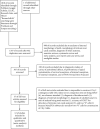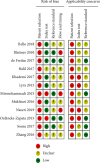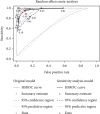Diagnostic Accuracy of CBCT for Detection of Second Canal of Permanent Teeth: A Systematic Review and Meta-Analysis
- PMID: 34335767
- PMCID: PMC8315866
- DOI: 10.1155/2021/1107471
Diagnostic Accuracy of CBCT for Detection of Second Canal of Permanent Teeth: A Systematic Review and Meta-Analysis
Abstract
Introduction: Missed canal is one of the common reasons for nonsurgical endodontic retreatments. The missed canals were frequently associated with periapical pathology. The aim of this systematic review was to find the diagnostic accuracy of CBCT for detection of the second canal of the root canal system of permanent teeth.
Materials and methods: The articles were selected from seven electronic databases according to selection criteria. All eligible studies were judged by the reviewers. The selected studies were checked with the QUADAS-2 tool for risk of bias and applicability concerns. Finally, 12 studies were selected for qualitative and quantitative analyses. The summary estimates of sensitivities and specificities and SROC curves were calculated and drawn by RevMan 5.3 and MetaDTA software.
Results: Summary estimates of CBCT for detection of second canal anatomy in permanent teeth were 94% sensitivity and 93.1% specificity. 96.6% sensitivity of MB2 was followed by 88.8% sensitivity of maxillary and mandibular premolars and 81% that of mandibular molars. The specificity of 97.6% for premolars was trialed by 85% specificity of mandibular molars and MB2. For permanent mandibular canines, 67% sensitivity and 100% specificity were estimated. CBCT showed more agreement with detecting the second canal with micro-CT, estimating 100% sensitivity and 95.6% specificity. The highest prevalence of the second canal comprised the highest sensitivity of 99.1% and lowest specificity of 77.5%. After the exclusion of case-control studies, a 3% drop of sensitivity from the summary estimate was observed. Multiple spectrum of the second canal had 8.6% higher sensitivity and 4.4% lower specificity than single spectrum.
Conclusion: CBCT is informative for detecting the second canal. Clinicians should keep in mind that the accuracy can vary in different types of teeth, with the prevalence of second canal across different populations, and with the spectrum of second canal anatomy in spite of the reviewers having postulated overestimation of the findings.
Copyright © 2021 Nyan M. Aung and Kyaw K. Myint.
Conflict of interest statement
The authors declare that they have no conflicts of interest.
Figures












Similar articles
-
Relationship between apical periodontitis and missed canals in mesio-buccal roots of maxillary molars: CBCT study.J Taibah Univ Med Sci. 2023 Sep 9;19(1):18-27. doi: 10.1016/j.jtumed.2023.08.009. eCollection 2024 Feb. J Taibah Univ Med Sci. 2023. PMID: 37868101 Free PMC article.
-
Root canal morphology of permanent teeth in a Malaysian subpopulation using cone-beam computed tomography.BMC Oral Health. 2019 Jan 14;19(1):14. doi: 10.1186/s12903-019-0710-z. BMC Oral Health. 2019. PMID: 30642318 Free PMC article.
-
Analysis of Bilateral Symmetry of Root Canal Anatomy in Permanent Dentition: An In Vivo CBCT Study in a Saudi Arabian Population.J Contemp Dent Pract. 2021 Aug 1;22(8):867-875. J Contemp Dent Pract. 2021. PMID: 34753837
-
Evidence of Second Canal between Permanent Mandibular Central and Lateral Incisors in China; a Systematic Review on CBCT Studies.Int J Dent. 2020 Dec 3;2020:8849609. doi: 10.1155/2020/8849609. eCollection 2020. Int J Dent. 2020. PMID: 33343667 Free PMC article. Review.
-
Root canal anatomy of human permanent mandibular incisors and mandibular canines: A systematic review.J Conserv Dent. 2022 May-Jun;25(3):226-240. doi: 10.4103/jcd.jcd_40_22. Epub 2022 Jun 13. J Conserv Dent. 2022. PMID: 35836556 Free PMC article. Review.
Cited by
-
Literature review and case study: unveiling the complexities of mandibular second molar with three distal canals.BMC Oral Health. 2024 Nov 13;24(1):1369. doi: 10.1186/s12903-024-05145-1. BMC Oral Health. 2024. PMID: 39538203 Free PMC article. Review.
-
Human Bone Typing Using Quantitative Cone-Beam Computed Tomography.Int Dent J. 2023 Apr;73(2):259-266. doi: 10.1016/j.identj.2022.08.011. Epub 2022 Sep 29. Int Dent J. 2023. PMID: 36182605 Free PMC article.
-
Artificial Intelligence (AI) for Detection and Localization of Unobturated Second Mesial Buccal (MB2) Canals in Cone-Beam Computed Tomography (CBCT).Diagnostics (Basel). 2022 Dec 18;12(12):3214. doi: 10.3390/diagnostics12123214. Diagnostics (Basel). 2022. PMID: 36553221 Free PMC article.
-
The Correlation between Intraorifice Distance and the Anatomical Characteristics of the Second Mesiobuccal Canal of Maxillary Molars: A CBCT Study.Int J Dent. 2024 Jan 29;2024:6636637. doi: 10.1155/2024/6636637. eCollection 2024. Int J Dent. 2024. PMID: 38318327 Free PMC article.
-
Variables That Affect the Ability to Find the Second Mesiobuccal Root Canals in Maxillary Molars.Iran Endod J. 2023;18(4):248-253. doi: 10.22037/iej.v18i4.42260. Iran Endod J. 2023. PMID: 37829834 Free PMC article.
References
-
- Dorland W. A. N. Dorland’s Illustrated Medical Dictionary. Philadelphia, PA, USA: Saunders; 2012.
-
- Ackerknecht E. H., Rosenberg C. E., Hausshofer L. A Short History of Medicine. Baltimore, MD, USA: Johns Hopkins University Press; 2016.
-
- Herrero-Hernández S., López-Valverde N., Bravo M., et al. Root canal morphology of the permanent mandibular incisors by cone beam computed tomography: a systematic review. Applied Sciences. 2020;10(4914):1–15. doi: 10.3390/app10144914. - DOI
-
- Martins J. N. R., Marques D., Silva E., et al. Influence of demographic factors on the prevalence of a second root canal in mandibular anterior teeth – a systematic review and meta-analysis of cross-sectional studies using cone beam computed tomography. Archives of Oral Biology. 2020;116:1–11. doi: 10.1016/j.archoralbio.2020.104749.104749 - DOI - PubMed
Publication types
LinkOut - more resources
Full Text Sources

